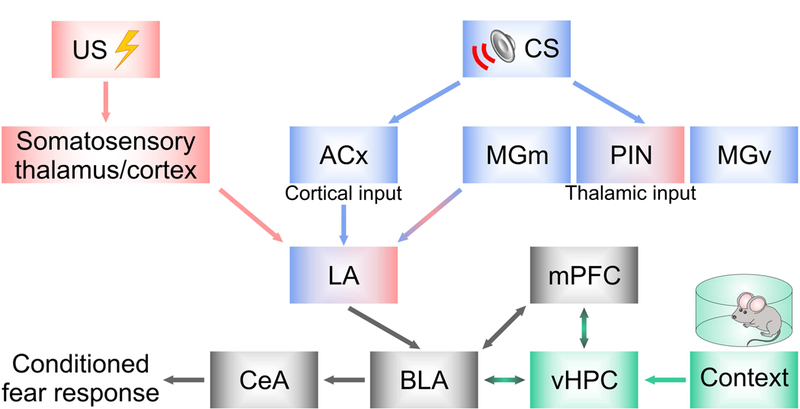Fig. 1.

A diagram illustrating brain circuitry of fear-related learning. During fear conditioning, the conditioned stimulus (CS) carrying auditory information (blue) is transmitted to the lateral nucleus of the amygdala (LA) by direct thalamic and indirect cortical pathways (LeDoux 2000; Maren 2001; Dityatev and Bolshakov 2005). Thalamic input to the LA arises in the medial subdivision of the medial geniculate nucleus and the adjacent posterior intralaminar nucleus of the thalamus (MGm/PIN). The auditory thalamus also sends projections to the auditory cortex (ACx). The latter, in turn, projects to the LA, thus forming indirect cortico-amygdala pathway. The LA receives somatosensory signals (red), coding the unconditioned stimulus (US) information from the somatosensory thalamus and cortex (Cruikshank et al. 1992; Shi and Cassell 1998; Shi and Davis 1999; Lanuza et al. 2008). The convergence of CS and US on LA neurons results in lasting synaptic enhancements in auditory CS inputs to the LA, contributing to the encoding of conditioned fear memory (Maren and Quirk, 2004). The signals are then relayed to other components of the learned fear circuits, including BLA, and eventually to the central nucleus of the amygdala (CeA). CeA mediates physiological manifestations of fear through divergent projections to the hypothalamus and brainstem areas (Maren and Quirk 2004). The ventral hippocampus (vHPC) projects to the BLA and is important for the encoding of context-dependency of fear-related behaviors (Herry et al. 2010; Orsini and Maren 2012). Medial prefrontal cortex (mPFC) modulates fear-related behaviors, both fear learning and extinction of fear memory, through its direct projections to the BLA (Milad and Quirk 2002; Likhtik et al. 2005; Quirk et al. 2006).
